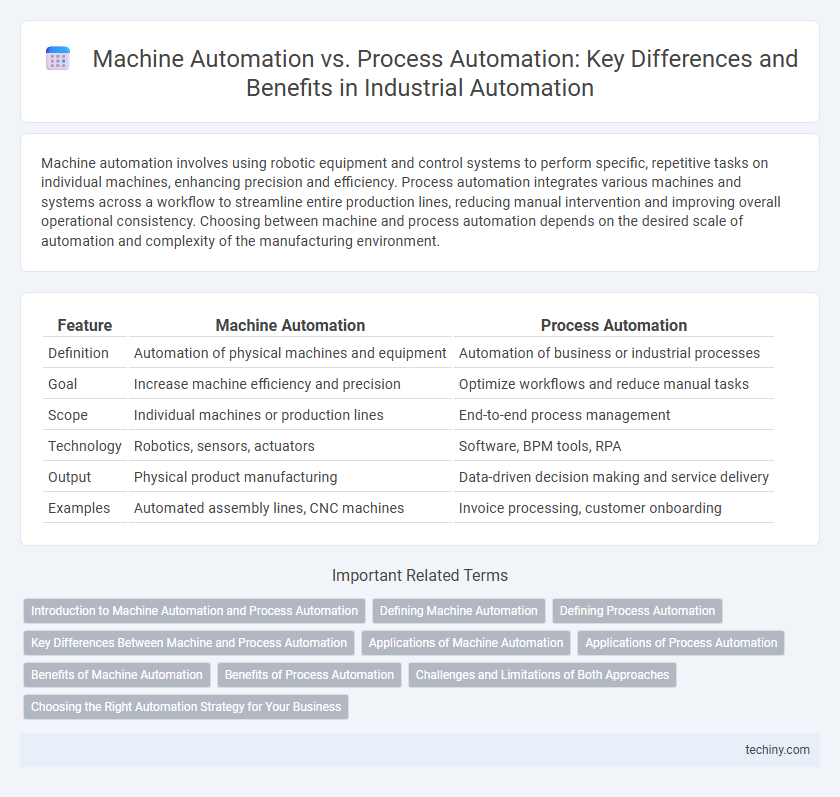Machine automation involves using robotic equipment and control systems to perform specific, repetitive tasks on individual machines, enhancing precision and efficiency. Process automation integrates various machines and systems across a workflow to streamline entire production lines, reducing manual intervention and improving overall operational consistency. Choosing between machine and process automation depends on the desired scale of automation and complexity of the manufacturing environment.
Table of Comparison
| Feature | Machine Automation | Process Automation |
|---|---|---|
| Definition | Automation of physical machines and equipment | Automation of business or industrial processes |
| Goal | Increase machine efficiency and precision | Optimize workflows and reduce manual tasks |
| Scope | Individual machines or production lines | End-to-end process management |
| Technology | Robotics, sensors, actuators | Software, BPM tools, RPA |
| Output | Physical product manufacturing | Data-driven decision making and service delivery |
| Examples | Automated assembly lines, CNC machines | Invoice processing, customer onboarding |
Introduction to Machine Automation and Process Automation
Machine automation involves the use of control systems, such as robots or CNC machines, to perform specific tasks with high precision and repeatability in manufacturing environments. Process automation, on the other hand, integrates advanced software systems like SCADA and DCS to monitor, control, and optimize entire industrial processes across various stages. Both machine and process automation leverage sensors, actuators, and real-time data analytics to enhance efficiency, reduce human intervention, and improve overall production quality.
Defining Machine Automation
Machine Automation involves the use of control systems such as robotics, computers, and programmable logic controllers (PLCs) to operate individual machines with minimal human intervention. It focuses on automating specific tasks within a single machine, improving precision, speed, and efficiency in manufacturing environments. Machine Automation is distinct from Process Automation, which integrates and optimizes entire workflows across multiple machines or systems.
Defining Process Automation
Process automation involves using technology to automate complex business workflows and operations, enhancing efficiency through systems integration and data management. It typically encompasses workflow automation, business process management (BPM), and robotic process automation (RPA) to streamline tasks across multiple departments. Unlike machine automation, which focuses on automating physical machinery or equipment, process automation targets end-to-end business processes to reduce manual intervention and increase operational agility.
Key Differences Between Machine and Process Automation
Machine automation focuses on the control and operation of individual machines or equipment, optimizing mechanical tasks through robotics, sensors, and embedded systems. Process automation streamlines entire workflows or production lines by integrating software-driven systems like SCADA, PLCs, and MES to enhance efficiency, consistency, and data management across multiple stages. Key differences include the scope of control--machine automation targets specific equipment, while process automation governs interconnected steps--and the level of complexity in coordinating various tasks and data flows.
Applications of Machine Automation
Machine automation is primarily applied in manufacturing environments where individual machines perform specific tasks to increase production speed and consistency, such as robotic arms in assembly lines and CNC machines for precision cutting. It enhances operational efficiency by reducing human error and downtime in repetitive tasks, enabling high-volume output with minimal intervention. In contrast to process automation, which manages entire workflows, machine automation focuses on optimizing discrete machine operations within larger production systems.
Applications of Process Automation
Process automation enhances operational efficiency by automating repetitive workflows such as invoice processing, customer onboarding, and inventory management across industries like finance, healthcare, and manufacturing. It leverages technologies like Robotic Process Automation (RPA) and Artificial Intelligence (AI) to reduce human error, accelerate task completion, and ensure regulatory compliance. Applications of process automation improve scalability and enable seamless integration with enterprise resource planning (ERP) and customer relationship management (CRM) systems.
Benefits of Machine Automation
Machine automation enhances production efficiency by enabling continuous operation with minimal human intervention, reducing errors and downtime. It improves precision and consistency in manufacturing tasks, leading to higher product quality and lower waste. Integrating machine automation also enables real-time data collection for predictive maintenance, optimizing equipment lifespan and reducing operational costs.
Benefits of Process Automation
Process automation streamlines complex workflows by integrating multiple tasks across various departments, significantly reducing operational costs and minimizing human error. It enhances organizational efficiency through real-time data processing and consistent task execution, leading to improved compliance and faster decision-making. Implementing process automation supports scalability and adaptability, allowing businesses to respond swiftly to changing market demands and enhance overall productivity.
Challenges and Limitations of Both Approaches
Machine automation faces challenges such as high initial costs, complexity in programming diverse equipment, and limited adaptability to dynamic production changes. Process automation encounters limitations including data integration difficulties, scalability issues across heterogeneous systems, and the need for continuous monitoring to maintain process efficiency. Both approaches require substantial upfront investment and ongoing maintenance, often demanding specialized expertise to mitigate risks and ensure seamless operation.
Choosing the Right Automation Strategy for Your Business
Machine automation targets individual equipment tasks by enhancing specific operations with robotics and control systems, improving speed and precision. Process automation integrates workflows across multiple machines and departments using software like BPM and RPA, streamlining complex business processes for higher efficiency. Selecting the right automation strategy depends on evaluating operational goals, scale, and the degree of customization needed to maximize ROI and maintain competitive advantage.
Machine Automation vs Process Automation Infographic

 techiny.com
techiny.com